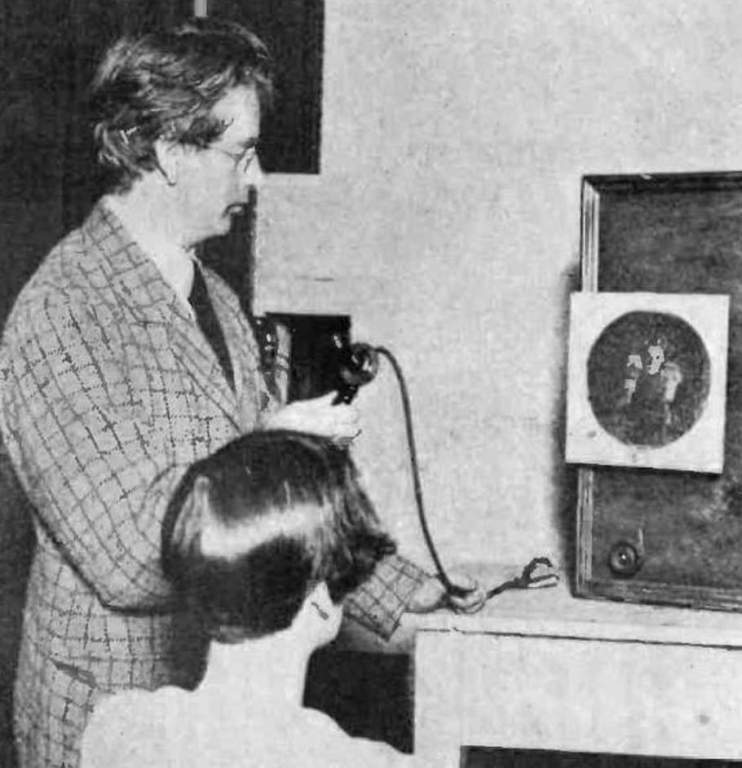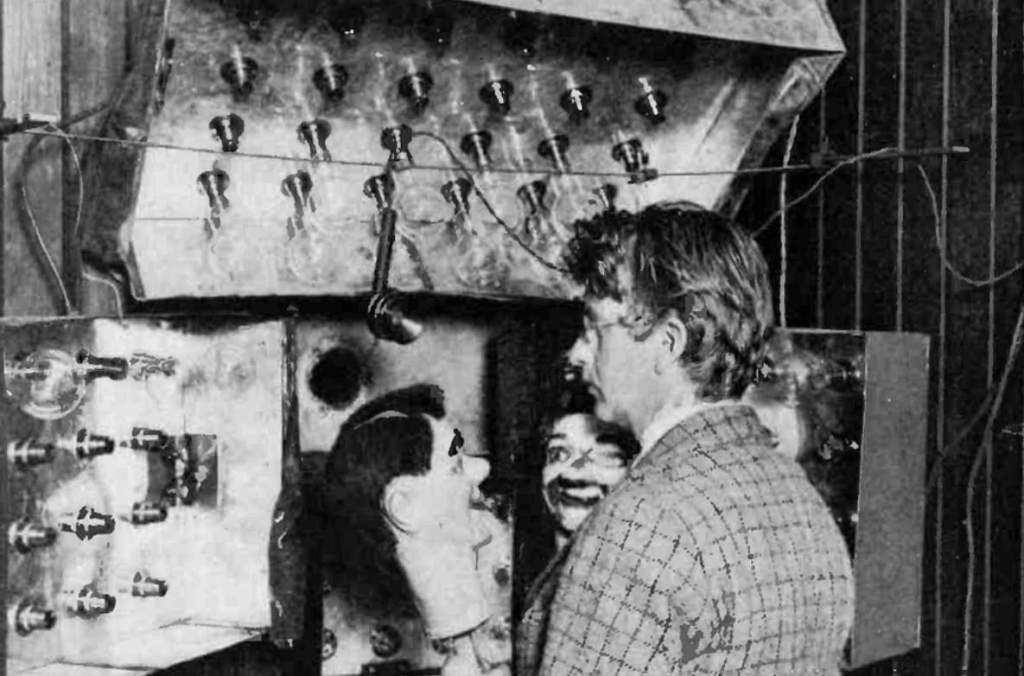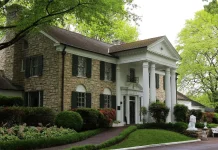A historical event of transmission of Shadows is actually a Inventors of Television. The wireless telegraphy was the means of providing a vital clue to the solution of the problem of transmitting vision. One summer’s afternoon in 1873 a young telegraphist named Joseph May sat basking in the warmth from the sunshine which streamed through the window of a signal’s office. The place was Valencia, Ireland, the European terminus of the transatlantic cable. Thus, Joseph May noticed an unfamiliar hum coming from the receiver and he leaned forward to see what was wrong.
As his hand passed over a resistance coil the hum changed to its usual note. He moved his hand backward and forwards, now near the coil, now some feet away. The hum adjusted its tone. Looking at the telegraph indicator needles, he saw that they too moved slightly. He deduced that the sunlight shaft was the cause. In addition, light, not heat, slightly affected the current passing through the selenium-covered coil.
Joseph May wrote a routine report which eventually caught scientists’ attention on both sides of the Atlantic. Immediately scores of them began to investigate the metal which converted light values into electric values. Many of them hoped that, by a reverse process, light could be made to produce current—a delightful situation in which a shaft of sunshine would send electromagnetic motors spinning steadily.
Others imagined an electric picture transmitted along a wire just like an ” electronic telephone”. They did not think of breaking the picture up and transmitting it piece by piece, and in any event, there was the insuperable difficulty of amplifying the very weak current passed by selenium, for the radio valve had not, of course, been invented at that time.

Ten years later a German, Paul Nipkow, invented a whirling metal disc pierced with holes. This allowed a focusing lens to scan an image and break it up into tiny fragments. The variations of tone could then be picked up by photo-electric cells, transmitted along a wire, and converted to light and shade by a neon tube projecting the rays through another revolving disc and a lens.
This was the ultimate goal of mechanical television visualized by nineteenth century pioneers. For more than twenty years the possibility of transmitting pictures remained a theory. The man who achieved it was born four years after Nipkow invented his disc. His name was John Logie Baird.
The son of a minister of the Church at Helensburgh, Dunbartonshire, John Logie Baird was a weak child. Because of long absences from school through chest and heart trouble, his career was quite undistinguished. However, everyone in Argyll Street, where the Baird family lived, remembered him. Scientific experiments connected with bicycles, photography, and telephones kept the district youth busy at weekends and aroused their parents’ misgivings.
Wires crisscrossed the road so Baird and his friends could converse from their bedrooms. Electric lights glowed dimly, flickered, and expired when the home-generating plant broke down. Baird’s father, who hoped his son would follow in his footsteps and enter the Church, realized engineering was his calling. This was if he could maintain his health, which seemed doubtful.
John Logie Baird applied to Glasgow Technical College for a course in electrical engineering and Glasgow University. Hence, shortly after his training was completed, the First World War broke out. John Logie Baird made a volunteer offer and was rejected. He then obtained an executive post at the Clyde Valley Electric Power Company. As soon as his day’s work was over, he experimented with television. His results seemed so promising that in 1919 he resigned from his job.
He had very no money and was unable to get enough to eat and buy equipment. He invented several gadgets sold to Glasgow shopkeepers. When his health showed signs of serious trouble, he went to the West Indies. He conducted a variety of small operations there, with no significant success, and the main objective—better health—eluded him.
Therefore, by 1921, he was back in England, and for a few months, he had a successful soap business. This terminated abruptly when he became seriously ill. His friends persuaded him to move to the sea, where, in their unspoken opinion, he could live out the few remaining months of his life in peace and relative comfort.
The place he chose was Hastings. Not one holiday-maker in a thousand ever saw the pathetically modest handheld tablet found in a shopping arcade in that town marking television’s birthplace. We are strange people, and our modesty about our citizens who deserve some appreciation is exasperating. This is mainly to overseas visitors, who usually know more about them than we do.
During the war, the writer was approached by an American officer strolling near the clock tower in the center of Hastings. The officer asked where Baird’s workshop was. ‘‘It’s the place where he invented television,” he explained.
It was only fifty yards away from where he stood when he found the memorable spot. The officer, who lived in civilian life was an executive of a Californian radio station, and then an Army radar expert. He had traveled from Dorset to see the birthplace of television, which he knew was in Hastings. He asked eight people, including a policeman, a postman, and Civil Defense officials. Unfortunately, none knew about it.
But the room in Queen’s Arcade deserves better recognition even though the environment is not inspiring. It was the cheapest Baird could find. He spent much of his time sitting on the porch, climbing painfully up Castle Hill, and reading in the nearby municipal reference library.
Gradually he assembled the equipment he wanted. One day he bought a tea chest at a grocer’s and carried it to his attic, where it became a motor housing. On the washstand, a biscuit tin housed the projection lamp. Ex-government wireless equipment was picked up after careful searching through junk stores; lenses came from second-hand shops. The scanning discs were cut from old cardboard. The whole device was mounted on scraps of wood and held together by glue, pins, and sealing wax.
This was the equipment that enabled John Logie Baird to beat some of the greatest commercial concerns in the world. This was in the race for electrical light and shadow transmission. In that rather shoddy room at Hastings Maltese crosses and letters of the alphabet were transmitted over a few feet of cable, and later by wireless. They were produced in shadowy silhouettes by a whirling disc.
John Logie Baird had an excitable, sociable character, and he was not shy about letting the press know what he was doing. Garbled accounts of the experiments appeared from which the public learned that something remarkable was in its early stages, even though not even the most optimistic reporter could pretend it had much entertainment or utilitarian quality.
However, the news brought financial help to the struggling Scotsman. He formed a company, packed equipment in crates, and returned to London. He rented an attic flat in Frith Street, Soho. The nine days’ wonder of Hastings died away from the Press columns and John Logie Baird returned to the uninteresting work of trial-and-error which was his method.
He had neither the training nor the temperament for paperwork. Inventories he made or circuits he designed were scribbled on the wall. Therefore, building, testing, tearing down, and building again was his maxim. One day Gordon Selfridge, Junior, son of the Oxford Street store founder, walked up the stairs to the Baird flat to see for himself what Baird was doing.
He was so impressed that he suggested a three-week demonstration at the store. John Logie Baird eagerly agreed, partly because he badly needed the £75 fee and also for the publicity the demonstration would provide. It took place in April 1925. “something” as Messrs. Gordon Selfridge said, “that should rank with the greatest inventions of the century.”

Many thousands saw the silhouette of a face—and most of them regarded the whole thing as a complicated toy. It was all forgotten very rapidly. By the end of the summer Baird’s resources had almost disappeared. To pay rent, he ate coffee and rolls in Old Compton Street cafés. Sooner or later, he was without means and had to ask his family for support. It was forthcoming. Another company was formed and John Logie Baird worked with that single-minded purpose which was his main strength. His aim was, of course, to reproduce an image with light and shade as well as an outline.
He reached his goal accidentally, as he himself subsequently said:
“One day, the fifth Friday in October 1925 I experienced the one great thrill which research work has brought me. The head of the ventriloquist’s doll which I used suddenly showed up on the screen as a real image with details and gradations of light and shade”.
Very excited, Baird ran downstairs and asked an office boy named Bill Taynton if he would like to earn half a crown. The youth agreed and was placed under a bank of lights while John Logie Baird ran into the adjoining room, where he had his receiver. The boy’s face was clearly visible, making him the first human to be televised. That was a historic moment for him.
A few days later, John Logie Baird invited Royal Society members to see a demonstration. They made their way up the stairs six at a time and watched television. On that night of 27 January 1926 Baird’s reputation, not to mention his financial security, was assured by the opinion of one of the greatest scientific bodies in the world.
John Logie Baird moved into larger offices and was immediately plunged into a contest he loved. Nevertheless, America had, independently, reached Baird’s goal only a few weeks after him. However various companies indulged in all sorts of feats of transmitting over long-distance telephone cables to bring television to the attention of the public.
John Logie Baird beat them at their own game. Pictures were transmitted between London and Glasgow in May 1927, and in January, he crossed the Atlantic, his own head as he sat in a Long Acre, London, the studio is seen, albeit distorted and blurred, in a suburb of New York. This feat was described by the New York Times as comparable to Marconi’s letter “S” transmission across the Atlantic.
Experimental broadcasts by the B.B.G. of the Baird television system began on 30 September 1929. They lasted until the end of September 1935, when the last programme was given. One reason for the termination was that the thirty-line mechanical system did not provide a sufficiently high reception quality to maintain interest.
Further, another was that in Britain and America, electronic television was ready for use. In the U.S.A. Dr. Vladimar Zworykin had patented the iconoscope as early as 1923 and had been working on electronic television ever since then, while in Britain the E.M.I. organization at Hayes, Middlesex, was working hard on research, under the direction of Alan Blumlein and Dr. J. D. McGee, two men whose work resulted in the television system of post-war Britain.
The device used to eradicate mechanical inefficiencies of television transmission and reception, with all their time lag and movement errors, was the cathode ray tube. This is an instrument capable of infinitely quick and accurate electrical impulse reaction.

Today it is a truism to say that the heart of the television receiver is the cathode ray tube. However, few people understand its method of operation or know the story of development behind this rather fearsome piece of apparatus. Although it was the demand for radar stations during the war that brought the cathode ray tube to its present degree of efficiency, the electrical phenomenon it controlled was known nearly ninety years ago.
Also, the name “cathode rays” was given by a German scientist named Goldstein. This was when he noticed him and a group of colleagues noted the effects of passing electric currents through a vacuum. This was the era when all sorts of tests were made to produce sparks across gaps. When the same idea was tried out with the gap inside a vacuum it was seen that quite different things happened—there were blobs of light on the surface of the container glass, for instance. Faraday first reported that when gas pressures were very low these light effects tended to move towards the anode. This left a patch of darkness just in front of the cathode at the other end. This was appropriately referred to as the Faraday space.”
Moreover, some 10 years later a scientist named Hittorf proved that the phosphorescent glow on the glass was due to some kind of matter that traveled in a straight line, no matter where the anode might be, and he also showed that it could be cut off by placing obstacles in the way. But, apart from showing what could be done, he did not explain it all. That was left to British scientist William Crookes.
He dismissed the suggestion that the enigmatic cathode rays were light rays. Instead, he believed they were electrical particles shot off at tremendous speed by electrical forces. He also succeeded in deflecting the rays to any part of the cathode end by using a magnet. This, as anyone with a television receiver will realize, was fundamentally the first crude version of the “heart of the television receiver. However, today’s users would not recognize Crookes’ tube.
It was only I feet long and of a weird shape where he left room for his mica screen and aluminum electrodes. Up to the nineteenth century, cathode ray tubes were made in scientists’ laboratories. In 1902, the first commercial tube was produced in a small city workshop owned by A. C. Cossor. It was a bizarre device, like an old motor horn in glass, with various small branches for electrical equipment.
An official investigation into television technique suggested that high definition was essential for a regular entertainment service. On 2 November 1936, John Logie Baird saw a twenty-year-old dream come true when the world’s first regular public television was inaugurated. But there was a bitter disappointment as well. The B.B.G. used two inventions alternately—the Baird 240-line system and the E.M.I. 405-line method. John Logie Baird’s system relied on mechanical scanning equipment which was a triumph of precision engineering.
But no skill or mechanical expertise could compare with the performance of the E.M.I. electron scanners. Everyone knew, though they could not say it, that John Logie Baird was beaten at the post. Too late he switched to an electronic camera himself. The race was over. The E.M.I. pictures were unrivalled.
John Logie Baird soon suffered another blow. One February night in 1937 all the experimental equipment owned by his company was destroyed in the fire at the Crystal Palace. This was where he set up an experimental station. He was now a fairly wealthy man and might have been content to draw substantial income from the firm bearing his name, which made receivers. He might also have been content to nurse his health. But the inventive genius still prodded him on, and he continued to work on color and stereoscopic television.
On 16 August 1944, in his laboratory in Sydenham, he demonstrated a color system using two cathode ray tubes. One gave a green picture and the other a red one. Two colors only (as such systems have proved in the cinema) are not really satisfactory. Three are needed. Nonetheless, this demonstration, given while the London Bomber attack was at its height, was probably the first all-electronic color television ever achieved.
John Logie Baird died at Bexhill, near the scene of his first triumph, after a few months of illness. He died on 14 June 1946, just one week after the B.B.C.’s television station, closed since September 1939, began transmissions again. He lived long enough to know that television was a major technical—and social—event of the age.
It was an invention that created a huge industry in its own right. It gave employment to tens of thousands and pleasure to millions in the principal countries of the world, with millions of pounds of capital involved. The man who created this industry left a total of £7OO in assets.







